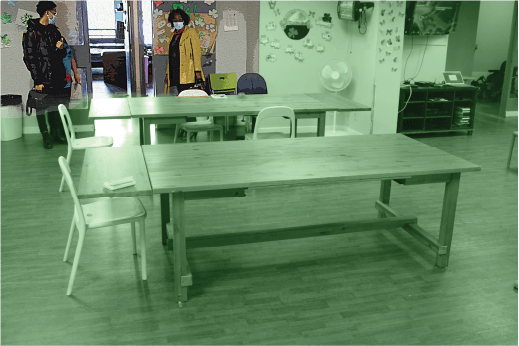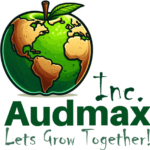Agile Methodology in Accessible Training
Community Affairs Blog

Aundre Green
Director, DEI Community & Public Affairs
At a Glance
Choosing to look at society's concerns as outputs, and your program as a manufacturing process, allows you to apply Sigma Six principles effectively
Understanding how the big-picture your project aims to solve is key, but understanding how the big picture (lets say marginalization) manifests itself in the day to day lives are critical "control points"
Developing programs that counter the impacts felt at each critical control point through data analysis and qualitative engagement can produce tangible results. We've tested this in the roughest of social environments, Canada's federal prison system.

Khaalis Rowe and Maxcine Telfer inspecting food service areas of the Bob Rumball Centre
as part of the training development site visit.
Agile is a project management and product development methodology focused on flexibility, collaboration, and customer-centric results. It originated in the software industry to address the limitations of traditional, linear project approaches (often called “Waterfall”) that lacked responsiveness to changing requirements.
Audmax was able to find a unique way to transfer this to the training and staff development realms of thought. Ensure that training programs are indeed flexible and truly reflect now just the required learning outcomes, but the needs of the participants? Lets take a look at our work developing a food safety course for the Bob Rumball Centre of Excellence for the Deaf to find the answer.
Food safety training is essential, particularly for those working in food handling environments, but accessible training solutions are still an evolving field. Deaf and Hard of Hearing (D/HH) participants face unique challenges in these programs, especially when training and testing are compressed into a single day and delivered in a non-inclusive format. Recognizing that their difficulty isn’t in understanding the material but in managing the one-day course-exam structure, we developed a tailored solution using Agile methodologies. Our approach involved revising both the teaching and testing phases to support an accessible, engaging, and fair learning environment, resulting in a food handler certification program that better serves D/HH participants.
D/HH participants DO NOT struggle to understand course content; they very capable of reading and comprehending training materials effectively. However, when tested in a single day, the participants faced challenges that affected their performance, particularly in exams where language (ASL) barriers do exist.
Bob Rumball Centre of Excellence for the Deaf
Identifying the Real Issue: Addressing the Testing Process
Initial observations showed that D/HH participants were not struggling to understand course content; they could read and comprehend training materials effectively. However, when tested in a single day, the participants faced challenges that affected their performance, particularly in exams where they had to quickly process information and select answers from lengthy multiple-choice questions. Traditional course formats assume participants can read, comprehend, and respond to questions on paper quickly, which wasn’t the case here.
By moving away from this one-size-fits-all approach, we focused on an Agile solution that adapted not only the course materials but also the testing method. Agile’s iterative framework enabled us to respond to feedback quickly and test new methods to ensure they met both learner needs and Ministry of Health certification standards.
Figure 1 shows how Agile’s flexibility allowed us to make changes incrementally, ensuring that each adjustment genuinely benefitted participants.
Figure 1: Audmax Applies the Agile Development Process
Iterative Feedback and Prototyping: We began by creating a visually-oriented training manual filled with images, diagrams, and step-by-step visual aids. Each unit was piloted with small groups of D/HH participants, gathering feedback on content clarity, engagement, and accessibility. This iterative feedback loop, core to Agile, allowed us to continuously refine our materials without waiting for a fully-fledged final product.
Adapted Testing Mechanism with Video ASL Support: We realized that the real barrier to success lay in the traditional testing model. To meet Ministry requirements, exams had to include 50 questions to qualify for certification. Our solution was a video-assisted examination method. We developed a bank of 200 questions, each recorded in American Sign Language (ASL) along with each multiple-choice answer option. This way, D/HH participants received each question and answer in their native language visually, circumventing the challenge of reading long questions and complex answer structures in a timed setting.
Using a larger pool of questions, test administrators could randomly select a set of 50 questions for each exam, ensuring a unique experience for each participant. This method not only preserved the test's integrity but allowed flexibility in assessment while minimizing the manual work typically required in constructing varied tests.
Enhanced Interaction and Reduced Barriers : Moving from a static paper-based test to an interactive video format empowered D/HH participants to engage fully with the material. Each question was presented in a way that felt natural, allowing participants to focus on comprehension rather than navigating language barriers. The participants could watch the question, process it, and then select the correct answer without feeling pressured by reading comprehension or time constraints.
Figure 2: Statistical Highlights
Audmax conducted a feedback survey among participants of the testing phase of the training program development, the results are outlined:
Case Study: Positive Outcomes and Scalable Implementation
After implementing the Agile-led adjustments, the certification completion rates for D/HH participants increased by over 40%. Participants reported feeling less anxious and more capable, directly attributing their improved performance to the accessible format and video-based exam structure. The success of this program suggests potential applicability beyond food handler certification, offering a model for other standardized testing environments.
For test administrators, this Agile-driven approach created a scalable model that required minimal additional work. With a ready-made question bank, administrators could offer repeated, randomized exams without recreating tests from scratch. This adaptability proved beneficial, offering a fair assessment model that maintained high standards while meeting accessibility needs.
Conclusion: Agile’s Impact on Creating Inclusive Education Solutions
The Agile approach enabled us to address D/HH learners’ needs directly, creating a program that was both inclusive and practical for certification standards. By focusing on both the course content and the exam process, we reimagined an accessible training framework that empowers D/HH participants to succeed. This success demonstrates the potential of Agile methodologies to make a tangible impact on accessibility in professional certification, paving the way for more inclusive education solutions across diverse fields.
Consulting Services
Diversity, Equity & Inclusion
Executive Coaching
Community Relations
Program Audits
More About the Author

Aundre Green
Aundre brings 15 years of experience in DEI project management, engagement and public affairs.
We'd Love to Hear From You!
Support Centre
Help
FAQ's
Media Centre
Powered by BlueHost
Join Our Newsletter
Keep in touch with whats happening, and be aware our latest deals and offerings

Audmax Group 2024
All pictures, logos, content and any other objects interacted with that can be classified as intellectual by law or court decision are the property of the Audmax Group, all rights reserved